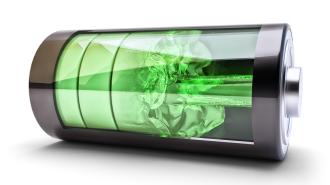This article is an installment of Future Explored, a weekly guide to world-changing technology. You can get stories like this one straight to your inbox every Thursday morning by subscribing here.
Many of the cheapest, cleanest sources of power are dependent on environmental conditions — turbines can’t spin if the wind isn’t blowing, and solar panels can’t harvest energy if the sun isn’t shining (usually).
Fossil fuels don’t have that consistency problem — you can burn coal or natural gas at any time to produce electricity — so we rely on them for times when renewable energy isn’t available.
Storing renewable energy when the supply is high can accelerate the transition to a world powered by clean energy, but traditional lithium-ion batteries — like the ones in your smartphone — aren’t perfect for this use.
Many of the cheapest, cleanest sources of power are dependent on environmental conditions.
That’s because those batteries self-discharge, meaning they’re constanting losing a bit of their stored energy. As a result, we can only store energy in them for a few days or weeks — we can’t bank power captured in the windy spring and use it in the relatively still fall.
Lithium-ion isn’t the only kind of battery, though.
Across the globe, groups are using other types of batteries — some well established, others brand new — for renewable energy storage. Here are a few of the alternative batteries helping the world decarbonize and transition to a more sustainable future — one grid at a time.
Water batteries
People have been using gravity to store energy for more than 100 years with pumped hydro storage systems, or “water batteries.”
These systems require two lakes or reservoirs, with one located at a higher elevation than the other.
When the grid has excess energy, it’s used to pump water from the lower reservoir to the higher one. When more power is needed, water from the upper reservoir flows down again, which drives hydroelectric turbines.

The advantages: Water batteries are one of the cheapest ways to store energy in terms of kWh, and we know they work — there are more than 150 already in operation, and they accounted for about 95% of the world’s energy storage capacity in 2020.
That means we don’t need to worry about developing new technologies to use them for renewable energy storage, and the US has enough technically feasible sites to double the amount of energy it stores in water batteries.
The drawbacks: Building water batteries is expensive and time-consuming, and constructing one in a place with few changes in elevation or no natural reservoirs is particularly costly.
Massive water batteries also face problems common to a lot of megaprojects: delays and cost overruns. The world’s largest pumped hydro project, Snowy 2.0 in Australia, is six years behind schedule and will cost three times more than originally planned (not counting upgrades to the grid to accommodate it).
Efficiency is also a concern: you lose 15-30% of your energy to the cycle of moving the water up and back down again, and some kinds of reservoirs (damming rivers, for example) can disrupt natural ecosystems.
The latest: The Nant de Drance pumped storage power plant in the Swiss Alps became operational in July 2022. With a storage capacity of 20 million kWh — as much as 400,000 electric vehicle batteries — it’s one of the most powerful water batteries in Europe (although just a fraction of the size of Snowy 2.0).
Developers dug more than 10 miles of tunnels to connect the Emosson and Vieux Emosson reservoirs for the water battery — in total, the construction process took 14 years and cost $2.1 billion.
Sand batteries
Another way to store excess renewable energy is to trap it as heat in some material, such as water, volcanic rock, or — the latest medium to be explored — sand, in a well-insulated container.
When electricity is needed, the heat from a sand battery can be used to boil water, creating steam that spins turbines. The heat can also be distributed directly as heat, keeping buildings warm in winter months and supplied with hot water year-round.
For some forms of clean energy, such as wind power, sand storage requires first converting electricity into heat, but solar and geothermal energy can be directly captured as heat — no conversion required.

The advantages: Sand is cheap, widely available, and easy to store. It can also be heated to higher temperatures than other battery mediums, such as water — with the right insulation, it could go higher than 980 degrees Celsius (1,800 degrees Fahrenheit).
Sand batteries could be built essentially anywhere — they can even be constructed underground to save land.
The drawbacks: Energy is lost when it’s converted from one medium to another, so a thermal battery isn’t as efficient for generating electricity as it is for direct heating.
New technology could change this, though — MIT recently unveiled a heat engine that converts heat to electricity more efficiently than a traditional turbine.
When the sand battery’s stored heat is used directly as heat, it is 99% energy efficient.
The latest: The world’s first commercial-scale sand battery is now operational in Finland. The battery looks like a silo, but instead of wheat, it’s filled with 100 tonnes of sand that can be heated to 500 C (932 F) using excess solar and wind power.
The sand battery has a 8 MWh capacity (roughly equal to 160 electric vehicle batteries), but unlike lithium-ion EV batteries, it can store that heat for months, with little loss. When the heat it stores is used directly as heat — which it currently is — it is 99% energy efficient, according to its maker, Polar Night Energy.
Flow batteries
Compared to water and sand batteries, flow batteries are a more technically complicated renewable energy storage solution.
They consist of two tanks of liquid electrolyte solution. In one tank, the solution is positively charged, and in the other, it is negatively charged. These solutions are pumped into a cell, where they remain separated by a membrane.
In this cell, the chemical energy of the solutions can be converted into electricity and discharged, or vice versa, through a process involving electrodes and the movement of electrons and ions.

The advantages: Compared to their lithium-ion cousins, flow batteries are less likely to catch fire and lose little storage capacity — even after thousands of cycles. Their self-discharge is low, and when the flow battery isn’t in use, it doesn’t lose any energy.
Flow batteries are easier to scale than lithium-ion batteries — instead of building more batteries, all you need to do is increase the size of your tanks — and because they don’t rely on geography, they can be installed in more locations than water batteries.
The drawbacks: Flow batteries are relatively new in terms of renewable energy storage — as of September 2021, global installed capacity was just 1.1 million kWh (~22,000 EV batteries) — so they aren’t as proven as water batteries.
Flow batteries also have a lower energy density than lithium-ion batteries — you need large tanks to store a lot of energy in them — and most of them require vanadium, a metal that is expected to increase in demand and cost.

The latest: In November 2021, MIT researchers published a paper detailing their creation of a new flow battery that replaces the traditional liquid electrolyte with a thicker, jet-black substance that resembles molasses.
The recipe for this electrically conductive mixture doesn’t include vanadium, and in testing, it outperformed traditional vanadium flow batteries in terms of both performance and cost — ironically suggesting that the future of energy could rely on a black sludge, just like the past.
We’d love to hear from you! If you have a comment about this article or if you have a tip for a future Freethink story, please email us at [email protected].






